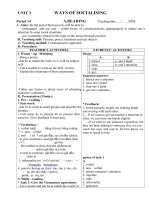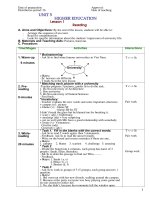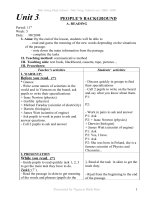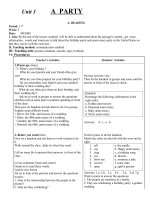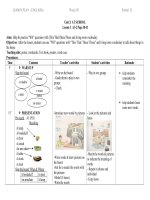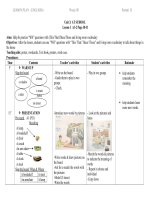Unit 3 CB K12 Moi
Bạn đang xem bản rút gọn của tài liệu. Xem và tải ngay bản đầy đủ của tài liệu tại đây (164.15 KB, 11 trang )
Date of preparation: Approval:
Distributive period: 13 Date of teaching:
Unit 3 Ways of socialising
Lesson 1 Reading
A. Aims and Objectives: By the end of the lesson, students will be able to:
- Guess meaning from context.
- Talk some back ground information of The ways of socialising.
- Understand and use non verbal forms of communications appropriately to attract ones
attention in some social situations.
- Summarize main idea.
B. Materials and Teaching Aids: Pictures, hand out.
C. Procedure:
Time/Stages Activities Interactions
1. Warm-up
6 minutes
- T comes to the class and does some unusual actions: wave, nod,
raise the hand
- T asks Ss to answer the question: What kind of action are these?
- T leads Ss in the lesson: Those are some ways of socializing.
* Lead in: Today we are going to learn some ways of socializing.
T <--> Ss
2. Pre-
reading
9 minutes
* Pair work
- Ask Ss to work in small groups and describe the pictures.
- Call some Ss to present pictures to present their answers. Give
feedback if necessary.
* Feedback
1. In the pictures, people are shaking hands and waving with each
other.
2. - If we want to get our teachers attention in class, we can raise
our hands slightly.
- If we need to ask someone a question, but they are busy
talking to someone else, we can catch his eyes and nod to let him
know we want to speak to him.
* Vocabulary :
1. verbal (adj) bằng lời nói, bằng miệng > < non verbal
2. nod ( n) cái gật đầu, sự cúi đầu (ch o);
- to give someone a nod: chào ai đó
- He nodded to show that the understood
- to nod to someone: gật ch o ai
3. informality (n) = ease ; > < : formality / formalness
4. to point to: hớng sự chú ý v o, chỉ ra.
- T explains the new words.
- T helps Ss read the new words.
Ss <--> Ss
T <--> Ss
3. While-
reading
19 minutes
* Task 1: Give the Vietnamese equivalents
- Use a poster and ask Ss to match the words in A with its
definition in B.
- Call some Ss to give answers.
A B.
1. verbal a. to come near to
2. non verbal b. concerned with words, oral , not written
or
gestures
3. attract someones attention c. concerned with gestures
4. impolite d. one will give a slight nod to another
5. rude e. antonym of polite
6. informality f. showing no respect or consideration
7. approach g. make somebody pay attention to
T <--> Ss
Ss <--> Ss
1
8. a slight nod will do h. friendliness
* Feedback
1 b; 2 c; 3 g; 4 e ; 5 f ; 6 h ; 7 a ; 8 d
- T may give the Vietnamese equivalents if needed.
- verbal (a); bằng lời
- non-verbal (a); không bằng lời, phi ngôn
- attract someone s attention: thu hut sự chú ý của ai
- impolite (a) # polite (a): không lịch sự
- rude(a) # polite: thô tục, thô bạo
- informality (adv) # formality: thân mật, không nghi thức
- approach (v): tiếp cận
- a slight nod will do: một cái gật đầu nhẹ là đủ
Task 2: Passage title
-Ask Ss to read the passage more carefully & choose the best title
for it.
- Let Ss discuss their answers with a friend.
- Call one student to give the answer and encourage them to
explain their choice.
- Further explain & give correct answer.
Answer key:
A. ( Attracting Attention: Non- verbal Cues)
Because different forms of non verbal communication are
mentioned in the passage.
Task 3: Answer the questions
- Ask Ss to work in 5 groups to ask and answer the questions.
- Call one student of each group to go to the board and write the
answer.
- Give feedback.
1. When we want to attract someones attention we can use verbal
or non verbal communication.
2. They are strong actions that can easily be seen.
3. We can wait until he passes near us, catch his eyes, and nod
slightly to let him know we would like him to come to our table.
Or we can raise our hand slightly to show that we need assistance.
4. You can use a small friendly wave to attract his /her attention.
5. Because pointing at someone is usually considerable rude.
T <--> Ss
T <--> Ss
T <--> Ss
Ss <--> Ss
3. Post-
reading
10 minutes
* Discussion: - Ask Ss to work in group to discuss the meanings
of whistling and hand clapping in Vietnamese culture.
- Elicit questions:
* When do people whistle or clap their hands?
* How do they feel when whistling or hand clapping?
* How do you think about these gesture ?
- Call some Ss to report the groups ideas.
- Correct and give comments.
Expected answers:
- In Vietnam people often whistle when they are in good spirit if
they want to attract someones attention. When they are in at a
performance, they usually whistle to give their compliments on the
performance of someone. But in some case this cause impoliteness
or rudeness.
Hand clapping is often used to give compliments or express
our agreement with someones ideas or opinions. Sometimes
teachers or parents clap their hands to draw attention of their
students or children.
Ss <--> Ss
T <--> Ss
4. Homework
1 minute
- Learn the new words by heart, read the text and do the tasks
again.
T <--> Ss
2
- Prepare the section B (The Speaking part of Unit three).
Date of preparation: Approval:
Distributive period: 14 Date of teaching:
Unit 3
Ways of socialising
Lesson 2 Speaking
A. Aims and Objectives: By the end of the lesson, students will be able to:
- Practise giving and responding to compliment in different situations.
- Improve their speaking skills.
B. Materials and Teaching Aids: Pictures, hand out.
C. Procedure:
Time/Stages Activities Interactions
1. Warm-up
6 minutes
- T wears a new dress, blouse or jeans and comes in the …
classroom.
- Ss may be surprised or interested in the new thing and they can
give comment in Vietnamese.
- T asks Ss: Do you like it?
What do you think about it?
Is it beautiful/ fashionable/ expensive?
- Ss may say in Vietnamese and T leads Ss in the lesson.
Today we are going to learn how to give compliment.
T <--> Ss
2. Pre-
speaking
9 minutes
* Task 1
- Introduces the task: You are going to work in your group to
practise reading these dialogues, paying attention to how people
give and respond to compliments in each situation.
Elicit the new words by asking Ps.
+ Vocabulary:
- compliments(n)
- hairstyle(n)
- terrific(a)
- kidding(a)
- Ask Ps to take notes and practise reading vocabulary.
- Ask Ps to work in pairs, practise reading these dialogues, paying
attention to how people give and respond to compliments in each
situation.
- T reads the dialogue once. Ask Ss to listen.
- Hang the table on the board. Ask Ss to look at the information
about compliments in the table.
• Useful language:
Give compliments Respond to compliments
- beautiful
- perfect
- I ve never seen’ …
- terrific
- better
- I think
- Thank you/ Thanks
- That s a nice compliment’
- I think…
- Ask Ss to use the information in the table and play the roles in the
dialogues to practise the dialogues.
- Move around to give help.
Ss <--> Ss
T <--> Ss
Ss <--> Ss
3. While-
speaking
* Task 2
- Ask Ss to read the information in the task.
- Explain the situations of each dialogue.
- Guide Ss to use suitable compliments in each dialogue, using the
T <--> Ss
3
19 minutes
cues.
- Ask Ss to work in pairs, practise giving compliments to suit the
responses.
- Move around to give help.
Feedback: Call on some pairs to act out their conversation in front
of the class.
Give comments on their conversations.
Feedback: The answers may vary
1.+ The dress looks nice on you.
+ I have never seen such a beautiful dress. It perfectly suits you.
+ Your dress looks great! I really like it.
2. + Your bike is terrific!
+ I love your bike! It's really wonderful.
+ Congratulation! You have a beautiful motorbike.
3. + Congratulation! You played a great game.
+ That’s fun! You played a great game.
+ I thought your badminton game was a lot better today.
+ You played a fantastic game of badminton today.
+ I didn’t know you could play badminton was so well.
* Task 3 : Practise responding to the compliments
-Ask Ss to work in pairs, practise responding compliments to suit
the responses.
- Move around to give help.
- Call on some pairs to act out their conversation in front of the
class.
- Give comments on their conversations.
Feedback : The answers may vary
Accepting:
1. You are too kind.
2. Thank you for saying so.
3. Thank you. I’m glad you like it/ you think so/ you enjoyed it.
Ss <--> Ss
T <--> Ss
T <--> Ss
Ss <--> Ss
3. Post-
speaking
10 minutes
*Task 4: Make dialogues to give and respond to
compliments.
- Ask Ss to work in pairs.
Models the 1st situation with a good student
T: The pair of glasses you are wearing are so nice, Phuong.
S :Thank you, Mrs. Nguyen. My friends gave them on my birthday.
- Move around to give help.
- Call on some pairs to act out their conversation in front of the
class.
- Give comments on their conversations
+ Rejecting
1. You’ve got to be kidding! I’m an awful dancer.
2. You’ve got to be kidding! I thought it was terrible.
3. No, I don’t. I look as awful as I feel.
+ Sample dialogue :
2) Lan: What a new and expensive watch you have, Tam.
Tam: I'm glad you like it. I bought it yesterday.
(3) Hoa: I like your new cell phone, July.
July: Thanks, Hoa. My father gave it to me.
(4 ) Tom: Your pair of shoes look modern, Jerry. I like them.
Jerry: Thank you, Tom. That's a nice compliment.
( 5) Nam: Your jacket is fashionable, Bruce.
Bruce: You must be kidding. It was 1990 fashion.
Ss <--> Ss
4. Homework
1 minute
- Learn the new words by heart and do the tasks again.
- Prepare the section B (The Speaking part of Unit three).
T <--> Ss
4
Date of preparation: Approval:
Distributive period: 15 Date of teaching:
Unit 3
Ways of socialising
Lesson 3 Listening
A. Aims and Objectives: By the end of the lesson, students will be able to:
- Use the telephone in their family.
- Improve their listening skills: Listening for main ideas and specific information.
B. Materials and Teaching Aids: Pictures, handouts, cassette, (colored) chalks.
C. Procedure:
Time/Stages Activities Interactions
1. Warm-up
6 minutes
- T shows the mobile and asks Ss to answer the question:
* How do you make a phone call?
+ Suggested answers:
- Talk politely
- Not late at night.
- Reasonable length of time for a call.
- The voice.
………………..
- T leads Ss in the lesson: We’re going to listen to Linda, who
advises young people on how to use the telephone in their family.
T <--> Ss
Ss
2. Pre-
listening
9 minutes
* Pair work :
- Ask Ss to work in pairs and answer the questions given in the
books.
- Call some Ss to act out in front of the class.
- Correct and give comments.
* Suggested answers:
1. They are taking on phone.
2. Hello, how are you?
3. They talk about friends, family…
4. About 15 or 20 minutes …..
* Vocabulary - Listen and repeat:
- Play the tape and then ask Ss to repeat after the tape in chorus
and individually.
- Explain some words.
1. Absolute (a) ho n to n, tuyÖt ®èià à
2. Starling (n) l m gÞ©t m×nhà
3. Chitchat (n) chuyÖn phiÕm
4. duration (n) kho¶ng thêi gian
5. stick (v) chÞu ®ùng
Ss <--> Ss
T <--> Ss
3. While-
listening
19 minutes
*Task 1: T / F statement
- Ask Ss to read through all the statements to find out what they
might hear, underline key words.
- Asks Ss to guess the answers in pairs.
- Ask Ss to do individually then compare the answer with a
partner.
T <--> Ss
5
